False scorpionfish
The false scorpionfish (Centrogenys vaigiensis), also known as prettyfins, is a species of perciform fish, the only species in genus Centrogenys, which in turn is the only genus in the family Centrogenyidae.[4] They are pale grey or brown and usually grow no longer than 25 cm (9.8 in). False scorpionfish are distributed throughout the Indo-West Pacific, bounded by the Ryukyu Islands of Japan to the north and Australia to the south, the Nicobar Islands to the west and New Guinea to the east.
| False scorpionfish | |
|---|---|
 | |
| Scientific classification | |
| Kingdom: | Animalia |
| Phylum: | Chordata |
| Class: | Actinopterygii |
| Order: | Perciformes |
| Superfamily: | Percoidea |
| Family: | Centrogenyidae Fowler, 1907[1] |
| Genus: | Centrogenys J. Richardson, 1842[2] |
| Species: | C. vaigiensis |
| Binomial name | |
| Centrogenys vaigiensis | |
| Synonyms[3] | |
| |
Description
False scorpionfishes can grow to a maximum length of 25 cm (9.8 in), but are usually no longer than 9.3 cm (3.7 in).[4] The operculum (bony covering of gills) has two spines, the lower of which is more conspicuous.[5] False scorpionfish have 36 to 44 lateral line scales.[5]
False scorpionfishes have 13 or 14 dorsal fin spines and 9 to 11 branched dorsal rays.[5] The base of the anal fin is short, and has three spines and five segmented rays. The second anal fin spine is the longest. The pectoral fins have 12 to 14 rays, whereas pelvic fins have one spine and three rays.[5] A membrane connects the inner pelvic ray to the body.[5]
The body overall is pale brown or grey. The fins may be the same colour or lighter, or even clear.[5] The ventral side is paler than the dorsal side, and large brown or grey spots mottle the pectoral and pelvic fins and also the forward portion of the anal fin. False scorpionfish feed upon small fishes, shrimps, and crabs.[5]
Mimicry
The false scorpionfish appears very similar to the true scorpionfish, to the point of originally being described as a species of Scorpaena.[6] This similarity protects the false scorpionfish from predators, which would not prey upon the very venomous true scorpionfish.
Distribution and habitat
They are brackish-water or marine fish, living in the benthopelagic layer.[4] Their range encompasses the Indo-West Pacific, from the Nicobar Islands to New Guinea, southwards to northern Australia, and as far north as the Ryukyu Islands of Japan.[4] False scorpionfish occur on rocky bottoms and reefs, almost always those with ample seagrass covering.[7] They are most commonly found in shallow waters along the coast.[4]
Relationship to humans
False scorpionfishes have little or no role in commercial fisheries.[5] However, they are occasionally found in home aquaria.[4][5]
References
- Richard van der Laan; William N. Eschmeyer & Ronald Fricke (2014). "Family-group names of Recent fishes". Zootaxa. 3882 (2): 001–230.
- Eschmeyer, W. N.; R. Fricke & R. van der Laan (eds.). "Centrogenys". Catalog of Fishes. California Academy of Sciences. Retrieved 26 February 2020.
- "Centrogenys vaigiensis". Integrated Taxonomic Information System. Retrieved 17 February 2010.
- Froese, Rainer and Pauly, Daniel, eds. (2010). "Centrogenys vaigiensis" in FishBase. January 2010 version.
- "The Living Marine Resource of the Western Central Pacific" (PDF). FAO Species Identification Guide for Fishery Purposes. Rome: Food and Agriculture Organization of the United Nations. 4 (Bony fishes part 2). 1999. ISSN 1020-6868. Retrieved 17 March 2010.
- Randall, John E. (2005). "A Review of Mimicry in Marine Fishes" (PDF). Zoological Studies. 44 (3): 302–304. Retrieved 18 March 2010.
- Tomascik, Tomas (1997). The ecology of the Indonesian seas, Part 2. Tuttle Publishing. p. 659. ISBN 978-962-593-163-0.
External links
- Photos of False scorpionfish on Sealife Collection